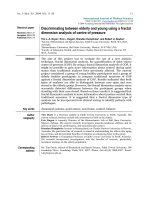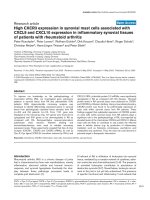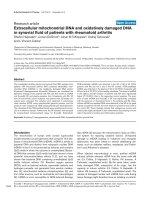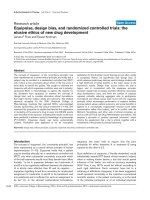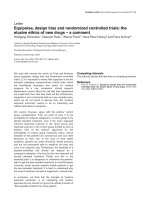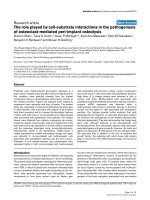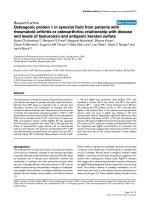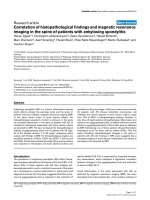Báo cáo y học: "Extracellular mitochondrial DNA and oxidatively damaged DNA in synovial fluid of patients with rheumatoid arthritis" potx
Bạn đang xem bản rút gọn của tài liệu. Xem và tải ngay bản đầy đủ của tài liệu tại đây (336.36 KB, 7 trang )
R234
Introduction
The mitochondria of human cells contain supercoiled
double-stranded circular genomes that comprise 16.5 kilo-
bases of mitochondrial DNA (mtDNA). mtDNA is similar to
bacterial DNA and distinct from eukaryotic nuclear DNA
(nDNA) in that it is not protected by histones and contains
CpG motifs in which the cytosine is unmethylated. Bacter-
ial DNA that contains CpG motifs has been shown to have
powerful immunostimulatory effects [1,2], and we have
shown that bacterial DNA containing unmethylated CpG
motifs induces arthritis [3]. Reactive oxygen species
(ROS), such as hydroxyl radicals, superoxide radicals, and
hydrogen peroxide, are generated from aerobic metabo-
lism [4], mitochondrial oxidative phosphorylation [5], and
from other sources, such as neutrophils and macrophages
[6]. mtDNA is more susceptible to ROS-induced damage
than nDNA [5] because the mitochondrion lacks an effec-
tive system for repairing oxidative lesions. Unrepaired
damage to mtDNA leading to mutations and energetic
dysfunction has been linked to several debilitating dis-
eases, such as diabetes mellitus, neoplasias, and Parkin-
son’s and Alzheimer’s diseases.
When injected intra-articularly in mice, purified mtDNA
induced arthritis whereas nDNA from the same cells did
not (LV Collins, S Hajizadeh, E Holme, I-M Jonsson, A
Tarkowski, unpublished work). By the same token, oxida-
tively damaged DNA, irrespective of its origin, has the
capacity to induce arthritis (LV Collins, S Hajizadeh, E
Holme, I-M Jonsson, A Tarkowski, unpublished work). The
release of damaged nuclear and mtDNA from cells during
tissue damage might therefore have an initiating or potenti-
8-oxodG = 8-hydroxy-2′-deoxyguanosine; mtDNA = mitochondrial DNA; nDNA = nuclear DNA; PCR = polymerase chain reaction; PL = plasma;
RA = rheumatoid arthritis; RF = rheumatoid factor; SDS–PAGE = SDS–polyacrylamide-gel electrophoresis; SF = synovial fluid.
Arthritis Research & Therapy Vol 5 No 5 Hajizadeh et al.
Research article
Extracellular mitochondrial DNA and oxidatively damaged DNA
in synovial fluid of patients with rheumatoid arthritis
Shahin Hajizadeh
1
, Jeroen DeGroot
2
, Johan M TeKoppele
2
, Andrej Tarkowski
1
and L Vincent Collins
1
1
Department of Rheumatology and Inflammation Research, University of Göteborg, Göteborg, Sweden
2
TNO Prevention and Health, Gaubius Laboratory, Leiden, The Netherlands
Corresponding author: Shahin Hajizadeh (e-mail: )
Received: 21 Mar 2003 Revisions requested: 29 Apr 2003 Revisions received: 15 May 2003 Accepted: 27 May 2003 Published: 25 Jun 2003
Arthritis Res Ther 2003, 5:R234-R240 (DOI 10.1186/ar787)
© 2003 Hajizadeh et al., licensee BioMed Central Ltd (Print ISSN 1478-6354; Online ISSN 1478-6362). This is an Open Access article: verbatim
copying and redistribution of this article are permitted in all media for any purpose, provided this notice is preserved along with the article's original
URL.
Abstract
We investigated whether plasma and synovial fluid (SF) samples from
patients with rheumatoid arthritis (RA) contained extracellular mito-
chondrial DNA (mtDNA) or the oxidatively damaged DNA adduct
8-hydroxy-2′-deoxyguanosine (8-oxodG). Moreover, we correlated the
laboratory findings of the patients with RA with their levels of mtDNA
and 8-oxodG. SF and plasma samples from 54 patients with RA, SF
from 30 non-arthritic control subjects, and plasma from 22 healthy vol-
unteers were collected. The samples were subjected to polymerase
chain reaction (PCR) using mitochondrial genomic primers, and the
products were analyzed by SDS–polyacrylamide-gel electrophoresis.
The intensities of the PCR-amplified bands were quantified and normal-
ized to a reference sample. Furthermore, the SF samples were assayed
by enzyme-linked immunosorbent assay for 8-oxodG. Extracellular
PCR-amplifiable mtDNA was detected in the SF of 38 of 54 (70%)
patients with RA, but not in any of the SF controls. PCR-amplifiable
mtDNA was detected in the plasma of 30 of 54 (56%) of patients with
RA and in 6 of 22 (27%) of the healthy volunteers. The levels of mtDNA
in the plasma and SF samples of patients with RA were significantly
higher (P <0.0001) than in the respective control samples. The pres-
ence of both mtDNA and 8-oxodG in SF was significantly correlated
with the presence of rheumatoid factor in the patients with RA. Extra-
cellular mtDNA and oxidized DNA were detected in the SF of the great
majority of patients with RA, but were absent or present at low levels in
the control SF. These findings indicate that endogenous nucleic acid
compounds might participate in joint inflammation by activating immune
cells in the joints to produce pro-inflammatory cytokines.
Keywords: 8-hydroxy-2′-deoxyguanosine, mitochondrial DNA, rheumatoid arthritis, synovial fluid
Open Access
Available online />R235
ating role in inflammation. We examined whether immunos-
timulatory mtDNA was involved in human arthritis by assay-
ing the levels of extracellular mtDNA in plasma and synovial
fluid (SF) samples from patients with rheumatoid arthritis
(RA) and from control subjects using amplification by poly-
merase chain reaction (PCR) with mitochondrial genomic
primers. We also investigated whether the levels of
8-hydroxy-2′-deoxyguanosine (8-oxodG), which is a marker
for oxidative DNA damage, differed in the joints of patients
with RA and control subjects. Our results indicate highly
significant differences in the SF levels of both 8-oxodG and
mtDNA between patients with RA and healthy subjects,
which suggests that these two DNA species might partici-
pate in joint inflammation.
Patients and experimental methods
Patient samples
The plasma and SF samples were collected simultaneously
with informed consent from 54 patients who were undergo-
ing diagnostic or therapeutic joint aspirations at the
Sahlgrenska University Hospital, Göteborg, Sweden. SF
was obtained by transdermal arthrocentesis. Before the
puncture, the skin surfaces of the joint were thoroughly
cleaned with a mixture of 0.2% chlorhexidine and alcohol.
To avoid contamination by bacteria or bacterial products in
the aspirated material during the procedure, sterile equip-
ment, such as needles, syringes and disposable gloves,
were used. SF was aspirated in a dry sterile syringe and
transported immediately into sodium citrate (0.129 M; pH
7.4). The same precautions were taken during plasma
sample collections from both the patients with RA and the
22 healthy volunteers. The average age (mean ± SE) was
50 ± 1 years for females, and 56 ± 4 years for males. The
control SF samples were collected post-mortem from 30
control subjects (predominantly traffic accidents) who
donated bone marrow for transplantation purposes. These
donors had no history of joint complaints, nor was any joint
pathology observed when the joint was opened.
Sample preparation and PCR assays
The samples were centrifuged at 500 g for 10 minutes,
then at 2000 g for 10 minutes, and the supernatants were
boiled for 10 minutes. After centrifugation in a microfuge
(11,000 g for 15 minutes at 4°C), the supernatants were
analyzed by PCR with the human mtDNA-specific primers
5′-GCTCTCCATGCATTTGGTAT-3′ (forward primer) and
5′-TTGTATTGATGAGATTAGTA-3′ (reverse primer). The
reaction mixture contained the forward and reverse
primers (each at 0.4 µM) in a total volume of 25 µl containing
2.5 µl of extracted SF in 10 mM Tris-HCl, pH 8.3, 50 mM
KCl, 4.0 mM MgCl
2
, 0.2 mM dNTPs (dATP, dCTP, dGTP,
and dTTP), and 1.25 U of Taq DNA polymerase (AmpliTaq
Gold; Perkin Elmer, Branchburg, NJ, USA). All of the SF
samples were subjected to 45 cycles of amplification,
each consisting of a 12-minute hot start at 94°C, denatu-
ration at 94°C for 30 seconds, annealing at 60°C for
30 seconds, and extension at 72°C for 1 minute. Samples
showing a PCR product of 453 base pairs (bp) on silver-
stained SDS–polyacrylamide-gel electrophoresis (SDS–
PAGE) gels were considered positive for the presence of
mtDNA. The detection limit of the PCR assay for mtDNA
was about 100 pg/ml.
Analysis of PCR products
After amplification, the PCR products were subjected to
SDS–PAGE in 4–20% Tris-borate-EDTA gels (Labora
AB, Sollentuna, Sweden) and the bands were revealed by
silver staining. The gels were scanned and the intensity of
each band on the gel was analyzed with IPLab Gel soft-
ware (BioSystematica, Plymouth, UK). The value obtained
for the 676-bp band in each gel was used as the cutoff
point for positive signals.
Control DNA samples for PCR
Purified mtDNA from human muscle mitochondria was
used as a positive control for the PCR. The negative
control consisted of the reaction mixture without template,
which was used to check for the presence of contaminat-
ing DNA in the PCR reagents and other components. In
addition, mtDNA could be amplified from mtDNA-negative
samples to which small amounts of purified mtDNA had
been added, confirming that the plasma and SF samples
did not contain PCR-inhibitory components.
Prevention of artefacts in PCR results
Because PCR assays are highly sensitive to trace contam-
inants, strict measures were taken to avoid artefacts.
These precautions included the use of sterile equipment
and dedicated pre-PCR and post-PCR rooms, pipettes,
laboratory coats, disposable gloves and waste containers.
To prevent any contamination from aerosols, pre-sterilized
filter tips were used (SDS, Falkenberg, Sweden) in all of
the PCR procedures. A PCR hood was used and the
pipettes, tips, PCR tubes and trays were irradiated with
ultraviolet light 30 minutes before either DNA extraction or
preparation of the PCR reaction mixtures.
Detection of 8-oxodG in SF samples
The SF samples were centrifuged at 500 g for 10 minutes
and then at 2000 g for 10 minutes; the supernatants were
boiled for 10 minutes. After centrifugation in a microfuge
(11,000 g for 15 minutes at 4°C), 100 µl aliquots of the
supernatants were treated with 100 µg/ml hyaluronidase
for 1 hour at 37°C. The samples were then heated to
95°C for 5 minutes, cooled rapidly on ice, and digested
for 2 hours with 10 U of nuclease P1 at 37°C, followed by
incubation for 1 hour at 60°C. Finally, the samples were
adjusted to pH 8.0 and treated for 1 hour with 2 U of
alkaline phosphatase at 37°C. The prepared samples
were assayed using a commercially available 8-oxodG-
specific competitive ELISA (OXIS Research, Portland,
OR, USA)
Arthritis Research & Therapy Vol 5 No 5 Hajizadeh et al.
R236
Statistical analyses
Differences between the groups in the levels of PCR-
amplified mitochondrial DNA in plasma and SF, and in the
levels of 8-oxodG in SF, were analyzed for statistical sig-
nificance with the Mann–Whitney test. Correlation
between laboratory features of the patients with RA and
the occurrence of mtDNA and oxidized DNA were analyzed
for statistical significance with the Mann–Whitney test, the
χ
2
test and Fisher’s exact test.
Results
Optimization of the PCR conditions
The optimum concentration of MgCl
2
for PCR amplifica-
tion of mtDNA was determined by analyzing PCR reac-
tions containing various concentrations (2.0, 3.0, and
4.0 mM) of MgCl
2
. In addition, serial dilutions (1:5, 1:20,
and 1:100) of plasma and SF samples were amplified by
PCR to detect the presence of inhibitors of Taq poly-
merase. Optimal PCR conditions were established by
using plasma or SF samples diluted 1:20 and with a con-
centration of 4.0 mM MgCl
2
.
PCR analysis of extracellular mtDNA in the clinical
samples
The results of a typical PCR analysis of plasma and SF
samples are shown in Fig. 1. Positive and negative
samples from SF and plasma samples, as well as positive
and negative controls for the PCR, were included in this
gel for comparative purposes. The samples were judged
to be positive or negative on the basis of the intensity
value for the PCR product on the gel (as assessed by the
IPLab Gel software) relative to the intensity value for the
676-bp band in the molecular mass standard.
The percentage of patients with PCR-amplifiable mtDNA
in their SF (Fig. 2) was significantly higher in the RA group
than in the control group (P < 0.0001). A comparison of
mtDNA-positivity in plasma samples from patients with RA
(30 of 54, or 56% positive) and healthy volunteers (6 of
22, or 27% positive) showed that mtDNA was detected
more often in the group of patients with RA (P = 0.025;
Fig. 2). These results show that patients with RA can be
easily distinguished on the basis of positive PCR results
for mtDNA in the SF.
To establish a semi-quantitative mechanism for assigning
the patients to various categories, we set the intensity of
the 676-bp band of the molecular mass marker on each
gel as the arbitrary cutoff point (Fig. 1, arrow). The intensity
Figure 1
Polymerase chain reaction (PCR) amplification of mtDNA from plasma and synovial fluid (SF) samples of patients with rheumatoid arthritis (RA).
SDS–polyacrylamide-gel electrophoresis of PCR-amplified mitochondrial DNA (mtDNA) fragments (453 bp) of plasma and SF of five patients with
RA. A semi-quantitative method was used to assign the PCR product intensities to positive or negative categories. An arbitrary cutoff point was
assigned that was relative to the intensity of the 676-bp band (arrow) of the molecular mass marker on the gel. Lane 1, molecular weight marker;
lane 2, water only (control); lane 3, plasma from patient 1 (plasma-1); lane 4, SF from patient 1 (SF-1); lane 5, plasma-2; lane 6, SF-2; lane 7,
plasma-3; lane 8, SF-3; lane 9, plasma-4; lane 10, SF-4. The samples in lanes 11 (plasma-5) and 12 (SF-5) were spiked with 10 ng of purified
mtDNA.
Figure 2
Percentages of rheumatoid arthritis (RA) and control subjects with
mitochondrial DNA (mtDNA) amplifiable by polymerase chain reaction
(PCR) in their plasma or synovial fluid (SF). Individual positivities are
based on the detection of the 453-base-pair mtDNA-specific PCR
product in the plasma or SF samples. Patients with RA, n =54; control
(SF), n =30; control (plasma), n= 22.
of this band corresponded to the intensity of the PCR
product when about 14 ng of PCR-purified mtDNA was
amplified by PCR from control SF. The PCR analysis
revealed the presence of extracellular mtDNA in the SF of
38 of 54 (70%) of the patients with RA that were included
in the study, whereas none of the control SF samples was
positive for mtDNA.
The results of this study suggested that the patients with
RA (Fig. 3) can be divided into four major categories
according to the relative intensities of their PCR-amplified
bands: category I (plasma
+
/SF
+
) is the largest group and
contains 26 patients (48%) with strong mtDNA signals in
both the plasma (PL) and SF; category II (plasma
+
/SF
–
) is
represented by 4 patients (7%) who had PCR-amplifiable
mtDNA in the plasma but not in the SF; category III
(plasma
–
/SF
+
) contains 12 patients (22%) with mtDNA in
the SF but not in the plasma; and category IV
(plasma
–
/SF
–
) includes those 12 patients (22%) who had
no detectable mtDNA in either plasma or SF.
Statistically significant differences in band intensities were
noted between patients in categories I and IV
(P < 0.0001), and between the patients in categories II
and III (P = 0.0036).
Levels of 8-oxodG in the SF
The mean level of 8-oxodG in the RA–SF samples was
3.2 ng/ml, and 41 of 49 patients with RA had more than
1.5 ng/ml 8-oxodG in their SF. In contrast, the mean
8-oxodG level in the control SF group was 1.5 ng/ml, and
16 of 30 of the control subjects had significant amounts of
8-oxodG in their SF (Fig. 4). The mean 8-oxodG level in
the joints of patients with RA was significantly higher
(P < 0.0001) that in the joints of the non-arthritic control
subjects (see Fig. 4).
Available online />R237
Figure 3
Comparisons of samples positive for mitochondrial DNA (mtDNA) (based on PCR fragment intensities on SDS–polyacrylamide-gel electrophoresis
[SDS–PAGE]) in plasma and synovial fluid (SF) samples both from patients with rheumatoid arthritis (RA) and from controls. The arbitrary cutoff
threshold is based on comparisons between the intensities of PCR-amplified mtDNA fragments and the 676-bp band on each SDS–PAGE (see
Fig. 1). Data points above the cutoff threshold indicate mtDNA-positive samples, and data points below the cutoff threshold indicate mtDNA-
negative samples. Correlations of the relative band intensities between plasma and SF samples from individual patients are indicated by lines
joining the corresponding data points. The samples from patients with RA (n =54) are divided into four categories (see the results section): I,
PL
+
/SF
+
; II, PL
+
/SF
–
; III, PL
–
/SF
+
; IV, PL
–
/SF
–
. The control samples were from two different groups of subjects. The control plasma (PL) samples
were obtained from healthy volunteers, and the control SF samples were recovered at autopsy from non-arthritic patients.
Figure 4
Levels of 8-oxodG in the SF of patients with rheumatoid arthritis (RA)
and of control subjects. The SF samples from patients with RA (n =49)
and non-arthritic controls (n = 30) were assayed by competitive ELISA
for 8-oxodG content (ng/ml). The horizontal bars show the mean
8-oxodG levels for each group: 3.2 ng/ml for the RA group; 1.5ng/ml
for the control group.
Relationship between laboratory features of the
patients with RA and occurrence of mtDNA and
oxidized DNA
The laboratory findings for the patients with RA used in
this study are shown in Tables 1 and 2. There was no sig-
nificant correlation between the presence of mtDNA in the
SF and parameters such as erosivity or extra-articular man-
ifestations (Table 1). Rheumatoid factor (RF) was
detected with significantly higher (P = 0.043) frequency in
patients that had mtDNA-positive SF than in patients
whose SF samples were mtDNA-negative. In addition,
there were no significant correlations between the pres-
ence of mtDNA in the SF and C-reactive protein, leuko-
cyte count platelet counts, disease duration, or medication
used (Table 1). There was a significant (P < 0.0007) corre-
lation between the level of 8-oxodG and RF positivity. In
contrast, no significant correlation was found between the
presence of 8-oxodG and other clinical or laboratory para-
meters (Table 2).
Discussion
Although DNA from specific viral (for example HTLV-1)
[7], bacterial (for example Borrelia, Chlamydia spp. [8],
Salmonella [9] and Yersinia [10]) sources has been
detected in the joints of arthritis sufferers, there is consid-
erable debate as to whether these nucleic acids have a
direct role in inflammation and joint destruction [11–13].
DNA containing unmethylated CpG motifs has been
reported to have immunostimulatory properties [14–16],
and the presence of this type of DNA in joints has been
linked with arthritides in mice [3] and humans [17]. More-
over, it has been suggested that CpG DNA might have a
role in other human autoimmune diseases such as sys-
temic lupus erythematosus [18]. mtDNA has similarities to
bacterial DNA and differs from eukaryotic nDNA in that it
is not protected by histones and has a higher frequency of
unmethylated CpG motifs. We have shown that purified
human and murine mtDNAs, as well as PCR-amplified
fragments of the human mitochondrial genome, induce
arthritis in mouse joints when injected intra-articularly (LV
Collins, S Hajizadeh, E Holme, I-M Jonsson, A Tarkowski,
unpublished work).
In the present study we detected the presence of extracel-
lular, PCR-amplifiable mtDNA in most (78%) clinical
plasma and SF samples from patients with RA that we
studied. There were notable differences between the
numbers of patients with mtDNA in their plasma
(P = 0.025) and SF (P < 0.0001) compared with the
plasma and SF samples from the respective controls.
Relatively high mtDNA-specific PCR band intensities were
obtained for the SF samples from patients with RA (Fig. 3),
which strongly suggests the presence of localized inflam-
mation leading to cellular destruction. Interestingly, the
patients with detectable levels of mtDNA in the SF also
tended to have significant levels of mtDNA in their blood-
stream (Fig. 3, category I). In contrast, patients who lacked
detectable free mtDNA in their SF usually lacked mtDNA
in their blood (Fig. 3, category IV), and the plasma samples
from healthy volunteers contained little or no mtDNA.
Thus, patients who have continuing joint inflammation that
is accompanied by elevated levels of mtDNA tend to have
Arthritis Research & Therapy Vol 5 No 5 Hajizadeh et al.
R238
Table 1
Correlation between expression of mtDNA and laboratory parameters in 54 patients with RA
Presence No. of
Analyte of mtDNA patients (%) RF+ Erosivity ExART CRP (mg/l) TPC (×10
9
/l) LPC (×10
9
/l)
Synovial fluid Yes 38 (70%) 33 (87%) 32 (84%) 13 (34%) n.d. n.d. 7.8 ±0.5
No 16 (30%) 10 (63%) 10 (63%) 4 (25%) n.d. n.d. 8.6 ±0.8
Blood Yes 30 (56%) 24 (80%) 26 (87%) 8 (27%) 38 ±6 354 ± 25 7.9 ± 0.6
No 24 (44%) 19 (79%) 16 (67%) 7 (29%) 45 ±12 357 ±29 8.1± 0.6
RA, rheumatoid arthritis; RF, rheumatoid factor; ExART, having extra-articular manifestations of RA; CRP, C-reactive protein; TPC, thrombocyte
particle count; LPC, leukocyte particle count, n.d., not done.
Table 2
Correlation of synovial fluid levels of 8-oxodG and laboratory parameters in 49 patients with RA
Level of
8-oxodG (ng/ml) Number of patients (%) RF+ Erosive ExART LPC (×10
9
/l)
>1.5 41 (84%) 36 (88%) 34 (83%) 13 (27%) 7.8 ±0.4
<1.5 8 (16%) 2 (25%) 5 (63%) 2 (25%) 8.0 ±1.3
RA, rheumatoid arthritis; 8-oxodG, 8-hydroxy-2′-deoxyguanosine; RF, rheumatoid factor; ExART, having extra-articular manifestations of RA; LPC,
leukocyte particle count.
free mtDNA in their bloodstream, either because they are
excreting free mtDNA or they have concomitant systemic
inflammation.
We further investigated whether a correlation existed
between the presence of free mtDNA and 8-oxodG in the
SF of patients with RA and the appearance of other labo-
ratory parameters, such as RF, erosivity, and extra-articular
manifestations. The presence of both mtDNA (P = 0.043)
and 8-oxodG (P < 0.0007) was significantly correlated
with the presence of RF, a diagnostic and prognostic
marker, in the patients with RA. No obvious correlation
was found between mtDNA detected in the SF and
markers of disease severity, such as erosivity, extra-articu-
lar manifestation, C-reactive protein, leukocyte particle
counts, thrombocyte particle counts, disease duration, or
medication used.
Because the injection of as little as 1 µg of mtDNA
induced arthritis in mouse joints (LV Collins, unpublished
work), we performed a theoretical calculation to investi-
gate whether an equivalent DNA load might be found in
inflamed human joints. An average human cell contains
approximately 10 fg (10
–15
g) of mtDNA. Given that an
inflamed human RA joint contains about 10
7
cells/ml in a
total SF volume of 10 ml, we can estimate the total mtDNA
content of the inflammatory cells in the joint as about 1 µg.
This calculation is rather crude and probably an underesti-
mate, because the concentration of cells in the SF and the
levels of cell death vary with the severity of arthritis and the
use of cytotoxic drugs. Nevertheless, it does demonstrate
that inflamed joints contain more than enough mtDNA to
induce the type of inflammation seen in mtDNA-injected
mouse joints. It is also worth emphasizing that the process
of inflammation in RA joints is dynamic, with the infiltration
of new inflammatory cells, the death of resident cells, and
the continuous secretion of DNA adducts, all of which
contribute to the inflammatory outcome.
High systemic levels of oxidatively damaged DNA, in par-
ticular 8-oxodG, are generally viewed as indicators of cel-
lular injury [19], and high local levels have been
associated with neuroinflammatory disease, for example in
the brain tissues of patients with multiple sclerosis [20].
Most interestingly, conditions of high oxidative stress have
previously been reported for the rheumatoid joint [21,22].
In this study, 8-oxodG was found to be present in the SF
from 41 of 49 patients with RA but 16 of 30 control subjects
had significant amounts of 8-oxodG in their SF
(P < 0.0001). It therefore seems that 8-oxodG is a marker
of inflammation in the joints of patients with RA.
Because the presence of 8-oxodG residues in DNA
strands, for example as a result of damage by free radi-
cals, is detrimental to cells, these adducts are normally
excised by repair mechanisms and excreted. When oxida-
tive damage to DNA is excessive, repair is not possible
and apoptotic mechanisms are induced. Although both
nDNA and mtDNA undergo oxidative damage [4], it is
intriguing to note, first, that mtDNA incurs far higher free-
radical damage than nDNA [23,24] owing to its proximity
to the respiratory chain, a lack of histones, and less effi-
cient DNA repair systems; and, second, that mitochondria
are instrumental in signaling cellular apoptosis in response
to overwhelming oxidative stress [25,26]. Furthermore, a
recent study has demonstrated that oxidative stress in the
RA joint not only damages the cellular DNA, but also sup-
presses the DNA mismatch repair system [27], which
would increase the overall load of DNA adducts in the
joint and exacerbate the disease. Most patients who had
mtDNA-positive SF also had significant amounts of
8-oxodG in their SF, indicating that oxidatively damaged
DNA might have a role in inflammation.
In this study we found that most patients with RA had PCR-
amplifiable mtDNA in their joints. We propose that endoge-
nous mtDNA released from cells undergoing necrosis
activates phagocytes to produce tissue-destructive
enzymes and cytokines, which contribute to the inflamma-
tory process. It seems likely that a combination of high levels
of reactive oxygen intermediates and the presence of DNA
adducts exacerbate cellular damage in inflammatory loci,
thus creating a vicious circle of inflammation and cell
destruction and an increased release of endogenous, pro-
inflammatory DNA. In the particular case of arthritis, thera-
pies might be envisaged that reduce overall oxidative stress
while minimizing the load of extracellular mtDNA in joints.
Competing interests
None declared.
Acknowledgements
We thank Dr M Bokarewa for collecting plasma and SF samples and
for characterizing the clinical features of the patients with RA. This
work was supported by grants (to LVC) from the Swedish Association
against Rheumatism, the Swedish Inflammation Network, the Nanna
Svartz Foundation, the King Gustav V foundation, the Swedish Medical
Research Council, and the EU Commission Biotechnology Program
(BIO4CT97-5130).
References
1. Sparwasser T, Miethke T, Lipford G, Borschert K, Hacker H, Heeg
K, Wagner H: Bacterial DNA causes septic shock. Nature
1997, 386:336-337.
2. Krieg AM: The role of CpG motifs in innate immunity. Curr
Opin Immunol 2000, 12:35-43.
3. Deng GM, Nilsson IM, Verdrengh M, Collins LV, Tarkowski A:
Intra-articularly localized bacterial DNA containing CpG motifs
induces arthritis. Nat Med 1999, 5:702-705.
4. Richter C, Park JW, Ames BN: Normal oxidative damage to
mitochondrial and nuclear DNA is extensive. Proc Natl Acad
Sci USA 1988, 85:6465-6467.
5. Yakes FM, Van Houten B: Mitochondrial DNA damage is more
extensive and persists longer than nuclear DNA damage in
human cells following oxidative stress. Proc Natl Acad Sci
USA 1997, 94:514-519.
6. Janssen YMW, Van Houten B, Borm PJA, Mossman BT: Cell and
tissue responses to oxidative damage. Lab Invest 1993, 69:
261-274.
Available online />R239
7. Bas S, Griffais R, Kvien TK, Glennas A, Melby K Vischer TL:
Amplification of plasmid and chromosome Chlamydia DNA in
synovial fluid of patients with reactive arthritis and undifferen-
tiated seronegative oligoarthropathies. Arthritis Rheum 1995,
38:1005-1013.
8. Nocton JJ, Dressler F, Rutledge BJ, MLT, Rus PN, Persing DH,
Steere AC: Detection of Borrelia burgdorferi DNA by poly-
merase chain reaction in synovial fluid from patients with
Lyme arthritis. N Engl J Med 1994, 330:229-234.
9. Nikkari S, Rantakokko K, Ekman P, Mottonen T, Leirisalo-Repo M,
Virtala M, Lehtonen L, Jalava J, Kotilainen P, Granfors K, Toivanen P:
Salmonella-triggered reactive arthritis: use of polymerase
chain reaction, immunocytochemical staining, and gas chro-
matography-mass spectrometry in the detection of bacterial
components from synovial fluid. Arthritis Rheum 1999, 42:84-89.
10. Gerard HC, Wang Z, Wang GF, El-Gabalaway H, Goldbach-
Mansky R, Li Y, Majeed W, Zhang H, Hgai N, Hudson AP, Schu-
macher HR: Chromosomal DNA from a variety of bacterial
species is present in synovial tissue from patients with
various forms of arthritis. Arthritis Rheum 2001, 44:1689-1697.
11. Kingsley G: Microbial DNA in the synovium – a role in aetiol-
ogy or a mere bystander? Lancet 1997, 349:1038-1039.
12. Soderlund M, von Essen R, Haapasaari J, Kiistala U, Kiviluoto O,
Hedman K: Persistence of parvovirus B19 DNA in synovial
membranes of young patients with and without chronic
arthropathy. Lancet 1997, 349:1063-1065.
13. Wuorela M, Granfors K: Infectious agents as triggers of reac-
tive arthritis. Am J Med Sci 1998, 316:264-270.
14. Krieg AM, Yi AK, Matson S, Waldschmidt TJ, Bishop GA, Teas-
dale R, Koretzky GA, Klinman DM: CpG motifs in bacterial DNA
trigger direct B-cell activation. Nature 1995, 374:546-549.
15. Scheule RK: The role of CpG motifs in immunostimulation and
gene therapy. Adv Drug Deliv Rev 2000, 44:119-134.
16. Sparwasser T, Miethke T, Lipford G, Boreschert K, Hacker H,
Heeg K, Wagner H: Bacterial DNA causes septic shock. Nature
1997, 386:336-337.
17. Van der Heijden IM, Wilbrink B, Tchetverikov I, Schrijver IA,
Schouls LM, Hazenberg MP, Breedveld FC, Tak PP: Presence of
bacterial DNA and bacterial peptidoglycans in joints of
patients with rheumatoid arthritis and other arthritides. Arthri-
tis Rheum 2000, 43:593-598.
18. Krieg AM: CpG DNA: a pathogenic factor in systemic lupus
erythematosus? J Clin Immunol 1995, 15:284-92.
19. Shigenaga MK, Aboujaoude EN, Chen Q, Ames BN: Assays of
oxidative DNA damage biomarkers 8-oxo-2
′′
-deoxyguanosine
and 8-oxoguanine in nuclear DNA and biological fluids by
high-performance liquid chromatography with electrochemi-
cal detection. Methods Enzymol 1994, 234:16-33.
20. Vladimirova O, O’Connor J, Cahill A, Alder H, Butunoi C, Kalman
B: Oxidative damage to DNA in plaques of MS brains. Mult
Scler 1998, 4:413-418.
21. Mapp PI, Grootveld MC, Blake DR: Hypoxia, oxidative stress
and rheumatoid arthritis. Br Med Bull 1995, 51:419-436.
22. Tak PP, Zvaifler NJ, Green DR, Firestein GS: Rheumatoid arthri-
tis and p53: how oxidative stress might alter the course of
inflammatory diseases. Immunol Today 2000, 21:78-82.
23. Yakes FM, Van Houten B: Mitochondrial DNA damage is more
extensive and persists longer than nuclear DNA damage in
human cells following oxidative stress. Proc Natl Acad Sci
USA 1997, 94:514-519.
24. Suter M, Richter C: Fragmented mitochondrial DNA is the pre-
dominant carrier of oxidized DNA bases. Biochemistry 1999,
38:459-464.
25. Kowaltowski AJ, Vercesi AE: Mitochondrial damage induced by
conditions of oxidative stress. Free Radic Biol Med 1999, 26:
463-471.
26. Loeffler M, Kroemer G: The mitochondrion in cell death control:
certainties and incognita. Exp Cell Res 2000, 256:19-26.
27. Lee S-H, Chang DK, Goel A, Boland CR, Bugbee W, Boyle DL,
Firestein GS: Microsatellite instability and suppressed DNA
repair enzyme expression in rheumatoid arthritis. J Immunol
2003, 170:2214-2220.
Correspondence
Shahin Hajizadeh, Department of Rheumatology and Inflammation
Research, University of Göteborg, Guldhedsgatan 10A, S-413 46
Göteborg, Sweden. Tel: +46 31 3424173; fax: +46 31 823925; e-
mail:
Arthritis Research & Therapy Vol 5 No 5 Hajizadeh et al.
R240

